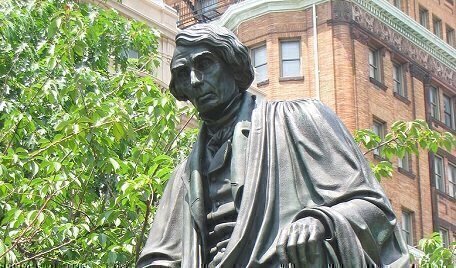This week, two monuments to former Chief Justice Roger Taney were labeled by some press outlets as “Confederate statues.” Taney, while controversial, was never a member of that self-proclaimed republic.
 The one statue was removed in Baltimore this week. A second, much-larger monument at the Maryland State House was given its marching orders by a four-person panel, including the state’s governor. That statue was removed under the cover of darkness early today.
The one statue was removed in Baltimore this week. A second, much-larger monument at the Maryland State House was given its marching orders by a four-person panel, including the state’s governor. That statue was removed under the cover of darkness early today.
Taney is best-known today as the author of the majority opinion in Dred Scott v. Sandford, the 1857 Supreme Court decision that invalidated the Missouri Compromise and held that African slaves or anyone descended from African slaves could never be United States citizens.
“The question is simply this: can a negro whose ancestors were imported into this country and sold as slaves become a member of the political community formed and brought into existence by the Constitution of the United States, and as such become entitled to all the rights, and privileges, and immunities, guaranteed by that instrument to the citizen, one of which rights is the privilege of suing in a court of the United States in the cases specified in the Constitution?” Taney asked in his opinion.
His answer is still controversial today. “We think they are not, and that they are not included, and were not intended to be included, under the word ‘citizens’ in the Constitution, and can therefore claim none of the rights and privileges which that instrument provides for and secures to citizens of the United States,” Taney said. “On the contrary, they were at that time considered as a subordinate and inferior class of beings who had been subjugated by the dominant race, and, whether emancipated or not, yet remained subject to their authority, and had no rights or privileges but such as those who held the power and the Government might choose to grant them.”
The Dred Scott decision is seen today and was seen in its time as one of the contributing factors that led to the Civil War. Among its biggest critics was Abraham Lincoln, who spoke at length about the case in his debates with Stephen Douglas.
By the time Taney joined the Supreme Court in March 1836, at the age of 60, he was one of the most controversial figures in Washington. Originally a Federalist, he switched sides to support Andrew Jackson’s administration. Taney had served briefly in several Cabinet positions for President Jackson, but the Senate rejected Taney’s nomination as Treasury Secretary and it blocked Jackson’s first attempt to place Taney on the Supreme Court. After John Marshall’s death, Jackson was able to get Taney on the Court, where he served 28 years as Chief Justice.
During that time, Taney’s record on slavery-related decisions was mixed up until the Dred Scott case. In Prigg v. Pennsylvania, Taney’s concurring opinion agreed that federal Fugitive Slave Laws applied to states like Pennsylvania that had enacted their own laws prohibiting the extradition of escaped slaves. However, Taney also signed on to the majority opinion in the Amistad case, which found that kidnapped free Africans pressed into slavery illegally under Spanish laws had a right to be free and return to Africa.
By 1857, Taney made headlines with the unabashed pro-slavery leanings in the Dred Scott decision. But as historian Timothy Heubner pointed out in a 2010 article in the Journal of American History, Taney had represented an abolitionist minister in an 1819 trial where Taney called slavery “a blot on our national character.” And in 1820, Taney had freed the slaves he inherited from his family.
By 1861, the shadow of the Dred Scott decision loomed over Taney’s remaining time on the Court with Lincoln as President. Taney, a Maryland resident, didn’t join the Confederacy. Instead, he remained on the bench and issued a rebuke of President Lincoln’s suspension of habeas corpus in Maryland, which Lincoln ignored.
While Taney remained a federal official during the Civil War, other prominent figures joined the Confederacy. John Breckinridge, a former United States Vice President and Senator, became a Confederate general. John Tyler, the former President, was elected to the Confederate Congress but died before he could join it. And Justice John Archibald Campbell, who served on the Supreme Court with Taney, resigned from the Court to serve in the Confederate War department.
Scott Bomboy is editor in chief of the National Constitution Center.







